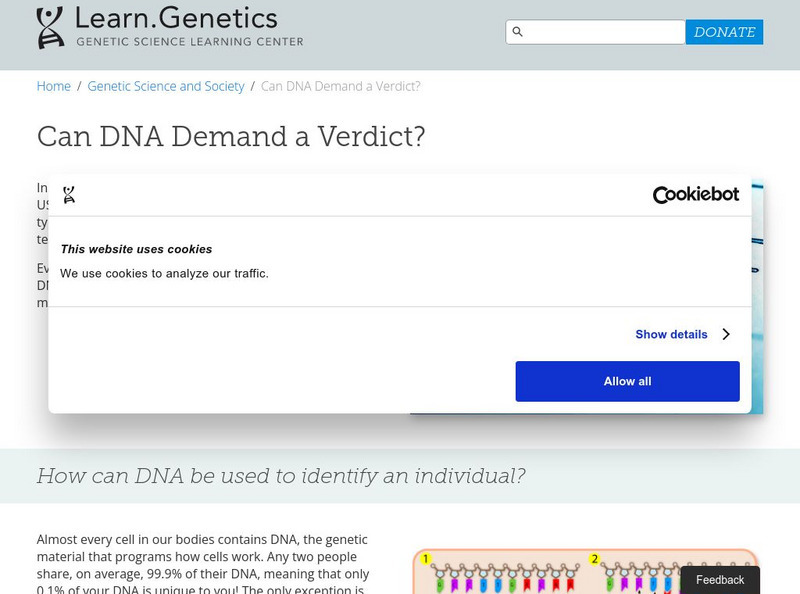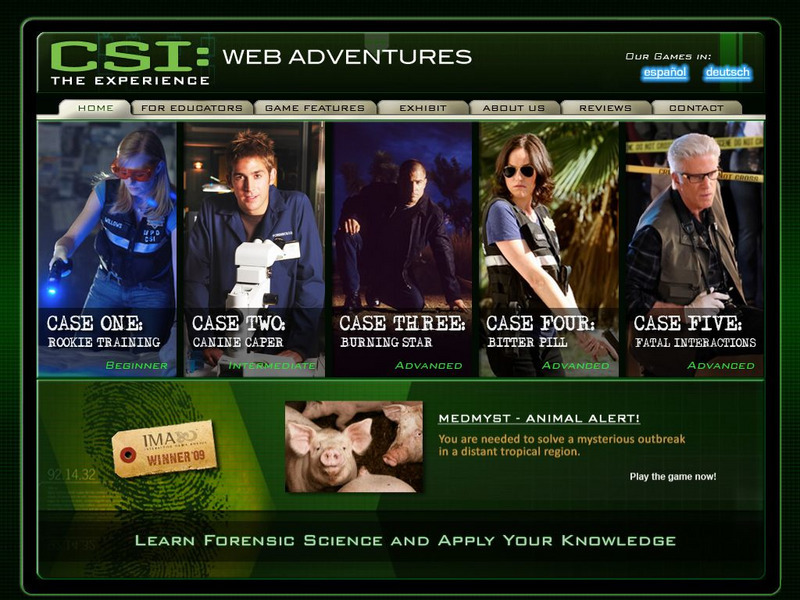Curated OER
DNA Fingerprinting Simulation
For this DNA fingerprinting simulation worksheet, students perform an activity that represents using a gel electrophoresis. Students decide who commits a crime in a forensics style lab.
Curated OER
Crime Scene Documentation
Students become forensic investigators. In this crime scene instructional activity, students go to the science lab which is the "scene of the crime." They collect evidence such as fingerprints, "blood" evidence, chromatography,...
Kenan Fellows
Unit 2: DNA Analysis
Ever wonder how they solve those mysterious murders in TV crime dramas? The second of four units in a Biotechnology series introduces scholars to the many methods of DNA analysis. Pupils create and run their own gel electrophoresis...
Curated OER
Classroom Identity
Students explore fingerprints. In this finger prints lesson, students investigate how to classify fingerprints. Students study large pictures of fingerprints and circle the patterns they know how to identify. Students then take their own...
Curated OER
Who's Who and How Do You Know for Sure?
Students investigate the applications of DNA fingerprinting, They read crime scenarios and using the details of the crime and laboratory experimentation decide the suspects guilt or innocence.
ConnectED
Crime Scene Investigation
How exactly does a crime scene investigation work? The resource, a unit on criminology, covers everything from the deductive reasoning skills needed for detectives to DNA fingerprinting, all the way to how to gather evidence and bring...
Curated OER
Genetics 5 Technology
Learners, after studying extraction and gel electrophoresis, recombinant DNA, transgenic organisms, and reproductive cloning, summarize the main concepts in DNA technology. They analyze the applications of DNA: forensics, medicine,...
Curated OER
Create A DNA Fingerprint
Young scholars engage in a lesson that is about the DNA molecule and focuses upon the sequencing of proteins to identify individuals. They conduct research using a variety of resources and then complete the activities included in the 3...
Curated OER
What Does That DNA Molecule Really Look Like???
Students extract DNA from animal liver cells. They separate, collect and describe the appearance from the extracted DNA while role playing as an intern in a city's forensics.
Curated OER
Biotechnology: Drug Delivery and Diffusion
Students discover advances in biomedical technology such as transdermal delivery and other non-invasive procedures. In lab activities, they examine how medication is given and how molecules travel, observe electrophoresis, and conduct...
Curated OER
Launch Biotechnology into Your Classroom: Drug Delivery and Diffusion
Students distinguish between diffusion and osmosis and describe ways that drugs can be administered. In this diffusion instructional activity students research career paths and create a presentation to give to the class.
Curated OER
Invent PCR: You May Win a Nobel Prize
Students gain an appreciation for the simplicity, but also complexity and elegance of PCR. They comprehend all components of the protocol. Students explain exactly how CPR works, and why, after the third cycle, the predominant DNA being...
Curated OER
Dig Magazine Archeology Quiz #106
In this Dig Magazine archeology quiz, students answer 12 multiple choice questions complementing the October 2009 issue. Page contains answer and additional resources link.
Georgia Department of Education
Ga Virtual Learning: Forensic Science: Fingerprint Analysis
Why are fingerprints unique to each individual? This comprehensive interactive tutorial explains how fingerprints are classified and stored in AFIS (Automated Fingerprint Identification System). Also explore how fingerprints are...
University of Utah
University of Utah: Genetic Science Learning Center: Dna and Verdicts
Part of a site on genetics, this page explores DNA as a forensic science. Explains how and why DNA can be used to convict or acquit a criminal from wrongdoing using forensic DNA analysis. Teacher resources too.
CK-12 Foundation
Ck 12: Biotechnology and Forensic Science
[Free Registration/Login may be required to access all resource tools.] Read this complete, illustrated article which gives a detailed look at the role genetics plays in forensic science.
PBS
Pbs Learning Media: Dna Fingerprint Photos
These photographs supplied by Genelex Corporation depict actual DNA fingerprints and show the types of information that can be gleaned from them.
Oak Ridge National Laboratory
Oak Ridge National Laboratory: Dna Forensics
A concise explanation of the use of DNA technologies in forensic identification from the Oak Ridge National Laboratory. Additional valuable resources are provided.
Museum of Science
Museum of Science and Industry: Online Science: Identify Your Fingerprints
Become a forensic investigator, and follow these simple step-by-step instructions to take, examine, and identify your fingerprints.
Rice University
Rice University: Web Adventures: Csi: The Experience
Based on the CSI television show, this series of four role-playing games helps students learn the scientific method and try their hand at solving crimes. Discover if you have what it takes to be a forensic scientist.
BiologyWise
Biology Wise: History of Dna Fingerprinting
Discusses the scientists who made discoveries about DNA and those who invented and worked on DNA fingerprinting, and some of the criminal cases that were resolved or thrown out through the use of DNA evidence. (Warning: Some of these...
Science Buddies
Science Buddies: Who Done It? Dna Fingerprinting and Forensics
DNA fingerprinting (also known as DNA profile analysis and DNA typing), is a method of distinguishing between individuals by analyzing patterns in their DNA. This project focuses on the first method of DNA fingerprinting to be developed,...
PBS
Pbs Learning Media: Forensics and Dna Profiling
Find out how DNA profilers analyze bits of tissue to identify human remains. From the NOVA: "Lost on Everest" Web site.
Michigan Reach Out
Fingerprinting: A Lesson on Classification
Who done it? Basic lesson plan to classify fingerprints. Young scholars can classify their own and classmates fingerprints by taking prints and comparing them to the handout provided.





















